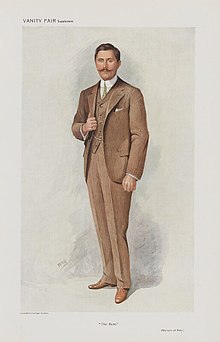|
John Crichton-Stuart, 4th Marquess of Bute
 John Crichton-Stuart, 4th Marquess of Bute, KT (20 June 1881 – 25 April 1947), was a Scottish peer.[1] BiographyBute was born at Chiswick House in Chiswick, London. He was the son of John Crichton-Stuart, 3rd Marquess of Bute and Gwendolen Fitzalan-Howard, a daughter of Edward Fitzalan-Howard, 1st Baron Howard of Glossop and granddaughter of Henry Howard, 13th Duke of Norfolk. He was educated at Harrow School, and succeeded his father as Marquess of Bute in October 1900, when he was nineteen years old. In early 1902 he was on a tour in the Far East. On reaching his majority in June 1902, he received the Honorary Freedom of the Burgh of Rothesay,[2] and later the same month took the oath and his seat in the House of Lords.[3] The 4th marquess, like his father, was a Knight of the Thistle.[1] He also had a passion for architecture and was responsible for restoring Caerphilly Castle in South Wales.[4] In 1936 he published a pamphlet entitled "A Plea for Scotland's Architectural Heritage", which argued for the preservation of Scotland's smaller burgh dwellings and advocated reconditioning traditional working class housing, rather than wholesale demolition.[5] He became "the man who sold a city" when, in 1938, he disposed of the remaining Bute family estate in Cardiff.[4] Bute HouseBetween 1903 and 1930, Bute bought and renovated a number of houses, No.s 5, 6, 7 and 8, in Charlotte Square in Edinburgh, making No.5 his townhouse. In 1949 his heir, the 5th marquess, moved his family to No.6 and placed No.5 on loan to the National Trust for Scotland.[6] In 1956, on his death, No.s 5, 6 and 7 were given permanently to the Trust in lieu of death duties.[7] No.6, Bute House, became the official residence of the Secretary of State for Scotland and is now the official residence of the First Minister of Scotland.[8] In the 21st century, revelations by Antony Beevor, in his study of the Spanish Civil War, The Battle for Spain, that the 4th Marquess, a Roman Catholic, had donated the proceeds from the sale of the estate's properties in Cardiff to help finance the regime change war by General Franco's Nationalist faction.[9] While this was done as a reaction to both the Red Terror and the religious persecution the Second Spanish Republic had unleashed against the Catholic Church in Spain, the revelation caused the 4th Marquess to be posthumously accused of Fascism and led to unsuccessful demands to the National Trust for Scotland for the renaming of Bute House.[10] Family lifeOn 6 July 1905, the young Lord Bute married Augusta Bellingham, daughter of Sir (Alan) Henry Bellingham, 4th Baronet, and Catherine Noel. The lavish Roman Catholic Wedding Mass, at Bellingham Castle in the village of Castlebellingham in County Louth, Ireland, was followed by a party at Mount Stuart House in Scotland. A film company was employed to film the event, one of the earliest examples of the aristocratic classes making a private film.[11] They had seven children:
AncestryReferences
Sources
External links |
||||||||||||||||||||
